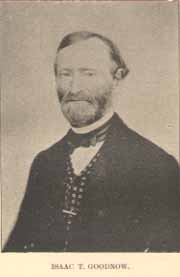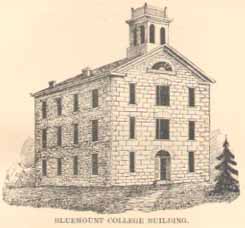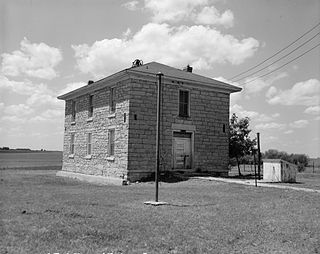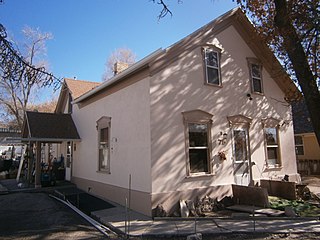
Pawnee Rock, one of the most famous landmarks on the Santa Fe Trail, is located in Pawnee Rock State Park, just north of Pawnee Rock, Kansas, United States. Originally over 150 feet (46 m) tall, railroad construction stripped it of some 15 to 20 feet (6.1 m) in height for road bed material. A memorial monument, picnic area, and pergola have been constructed on the top. From the top of the pergola is a view the Arkansas river valley and the route of the Santa Fe trail. Today it is a prominence rising 50 or 60 feet above the surrounding plains. Matt Field, who traveled the Santa Fe Trail in 1840, later wrote, "Pawnee Rock springs like a huge wart from the carpeted green of the prairie." Traders, soldiers, and emigrants who stopped, carved their names into the brown sandstone. Some of these names are still visible among the graffiti of the more recent visitors.

Fort Larned National Historic Site preserves Fort Larned which operated from 1859 to 1878. It is approximately 5.5 miles (8.9 km) west of Larned, Kansas, United States.

Nicodemus National Historic Site, located in Nicodemus, Kansas, United States, preserves, protects and interprets the only remaining western town established by African Americans during the Reconstruction Period following the American Civil War. The town of Nicodemus is symbolic of the pioneer spirit of African Americans who dared to leave the only region they had been familiar with to seek personal freedom and the opportunity to develop their talents and capabilities. The site was named, at least in part, for a legendary African-American slave featured in abolitionist Henry Clay Work's "Wake, Nicodemus (1864)." It is a mystical story of an old slave died away and buried in a hollow tree who had asked to be awakened on the Day of Jubilee.

Grinter Place is a house on the National Register of Historic Places above the Kansas River in the Muncie neighborhood of Kansas City, Kansas.

Isaac Tichenor Goodnow was an abolitionist and co-founder of Kansas State University and Manhattan, Kansas. Goodnow was also elected as a Republican to the Kansas House of Representatives and as Superintendent of Public Instruction for the state, and is known as "the father of formal education in Kansas."

The Red Rocks State Historic Site is a Kansas historic site at 927 Exchange Street in Emporia, Kansas. It preserves the William Allen White House, also known as Red Rocks, which was the home of Progressive journalist William Allen White from 1899 until his death in 1944. The house was declared a National Historic Landmark in 1976. The property, designated a state historic site in 2001, is operated by the Kansas Historical Society.

Lecompton Constitution Hall, also known as Constitution Hall, is a building in Lecompton, Kansas, that played an important role in the long-running Bleeding Kansas crisis over slavery in Kansas. It is operated by the Kansas Historical Society as Constitution Hall State Historic Site.

The Hollenberg Pony Express Station, also known as Cottonwood Pony Express Station, is the most intact surviving station of the Pony Express in the United States. It was built by Gerat H. Hollenberg in 1858, to serve travelers on the Oregon and California Trails, and was used by the Pony Express when it was established in 1860. The station is owned by the state of Kansas and is operated by the Kansas Historical Society as Hollenberg Pony Express Station State Historic Site. It was designated a National Historic Landmark in 1961.

The Kansas Historical Society is the official state historical society of Kansas.
The Iowa and Sac & Fox Mission State Historic Site, also known as the Highland Presbyterian Mission, is the site of a mission that housed the children of two local tribes between 1845 and 1863.

The John Brown Museum, also known as the John Brown Museum State Historic Site and John Brown Cabin, is located in Osawatomie, Kansas. The site is operated by the Kansas Historical Society, and includes the log cabin of Reverend Samuel Adair and his wife, Florella, who was the half-sister of the abolitionist John Brown. Brown lived in the cabin during the twenty months he spent in Kansas and conducted many of his abolitionist activities from there. The museum's displays tell the story of John Brown, the Adairs and local abolitionists, and include the original cabin, Adair family furnishings and belongings, and Civil War artifacts.

The McCall Street Historic District in Waukesha, Wisconsin is a historic district that was first listed on the National Register of Historic Places in 1983. In 1983 it included 51 buildings deemed to contribute to the historic character of its 13-acre (5.3 ha) area. In 1993 the boundaries were increased to include a 40-acre (16 ha) area having 100 contributing buildings.

Blue Mont Central College was a private, Methodist institute of higher learning located in Manhattan, Kansas, United States. The college was incorporated in February 1858, and was the forerunner of Kansas State University.

The Old Allen County Jail is a former jail in Iola, Kansas, United States. Built in the late 1860s, it operated as a detention facility for nearly a century before a replacement opened; today, it is the Old Jail Museum, operated by the Allen County Historical Society, and it has been designated a historic site.

The Marais des Cygnes Massacre Site, also known as Marais des Cygnes Massacre Memorial Park, is a state historic site near Trading Post, Kansas that commemorates the 1858 massacre of the same name. On May 19, 1858, during a period of political instability and sporadic violence known as Bleeding Kansas, a group of pro-slavery border ruffians captured 11 abolitionist free-staters. The prisoners were forced to a nearby ravine, where 10 of them were shot, resulting in five fatalities. The abolitionist John Brown later built a fort near the site. The first commemoration at the site was two stone markers erected by men of the 3rd Iowa Cavalry Regiment in 1864, although these monuments had been destroyed by souvenir hunters by 1895. In 1941, the land where the massacre occurred, as well as an 1870s-era house constructed by a friend of Brown, were transferred to the state of Kansas. The site was listed on the National Register of Historic Places in 1971 and designated a National Historic Landmark in 1974. The Kansas Historical Society administers the site, which is interpreted by signage and a hand-cranked audio recording.

Old Castle Hall was the first building of Baker University in Baldwin City, Kansas. It was built in 1857-58 to house the university on its first two floors, with the Palmyra Masonic Lodge occupying the third floor. It was used for classes until 1871, when other buildings were constructed for the purpose, and later used as a mill, a dormitory and for storage. The third floor was rebuilt during its service as a mill to address structural problems.

The Old Albany Schoolhouse is a structure in Nemaha County, Kansas that was used as a school from the time of its construction circa 1866–67 to 1963. The school is one of the last remnants of the town of Albany, which declined after a railroad was built closer to the neighboring town of Sabetha. The school is a two-story rough limestone structure in the Plains Vernacular style. The corners are marked with quoins, and the school is covered by a hipped roof. After brief service as a church the school became the a museum in 1965, and now serves as the centerpiece of the Albany Museum complex. Other buildings include a railroad museum, windmill, caboose, antique automobiles, tractors and a 1950s period farmhouse. s

The Oluf Larsen House, at 75 S. 100 West in Ephraim, Utah, is a historic pair-house which was built in 1870. It was listed on the National Register of Historic Places in 1983.

The William C. & Jane Shaft House is a historic house at 1682 FP Road north of Clements, Kansas. The original house was built in 1857 by William C. Shaft and his son William H.; the rest of the Shaft family, including his wife Jane, moved to the site later in the year, making them one of the first pioneer families in Chase County. William C. Shaft drowned the following year, and Jane attempted to return to the family's previous home in Michigan; however, her children convinced her to keep the family in Kansas. William and Jane's five sons built a two-story addition to the house in 1868, engraving the cornerstone with Jane's name. The stone house has a vernacular gable front and wing plan, which was common in homes built in multiple stages. As there were few other buildings in the area, the Shaft family ran a post office in their home and hosted early community gatherings for other settlers.





















